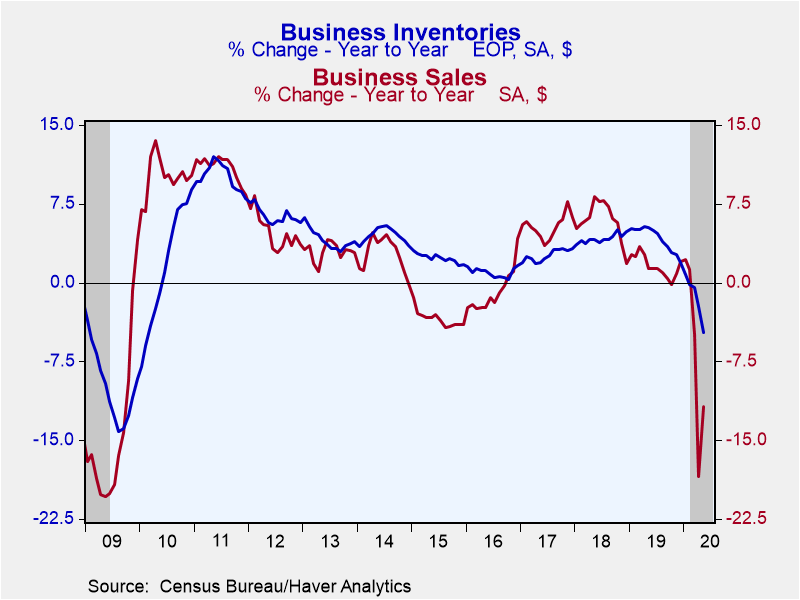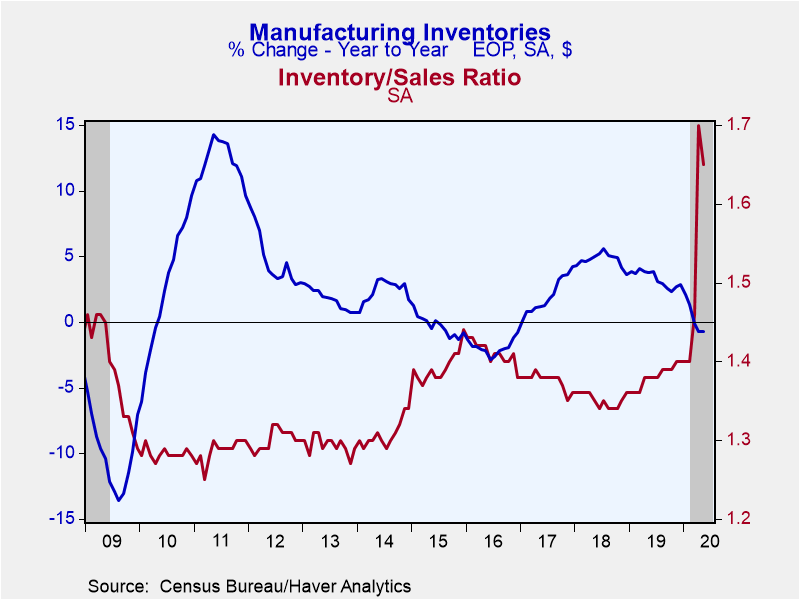 Global| Jul 16 2020
Global| Jul 16 2020U.S. Business Inventories Fall in May as Sales Outweigh Production
Summary
• Business inventories down 2.3% in May; fifth consecutive monthly decline. • Sales jump 8.4%, but still 12.5% below January peak. • Inventory-to-Sales ratio decreases to a still elevated 1.51. Total business inventories dropped 2.3% [...]
• Business inventories down 2.3% in May; fifth consecutive monthly decline.
• Sales jump 8.4%, but still 12.5% below January peak.
• Inventory-to-Sales ratio decreases to a still elevated 1.51.
Total business inventories dropped 2.3% in May (-4.8% year-on-year) after decreasing a downwardly-revised 1.4% in April (was -1.3%). This is the fifth consecutive monthly decline in inventories. Total business sales jumped 8.4% (-11.8% y/y) after plummeting an unrevised 14.4% in April. This leaves sales 12.5% below their January peak. The inventory-to-sales (I/S) ratio dropped to 1.51 from its 17-year high of 1.67 (unrevised).
Manufacturing output as well as imports -- neither of which are reported in this release -- drive a wedge between inventories and sales. Despite 3.8% growth in May, factory production was down 17.2% from its December 2019 peak. Business inventory swings can have a meaningful impact on GDP. In the first quarter inventories subtracted 1.56 percentage point to GDP growth. In the second quarter any inventory swings will be overwhelmed by shifts in the final sales components such as consumption and investment.
Retail inventories fell 6.2% in May (-9.6% y/y). Auto inventories, which comprise roughly 30% of retail inventories, dropped 14.9% (-21.4% y/y). Non-auto retail inventories contracted 1.6% (-3.0% y/y). General merchandise inventories, the second largest sector declined 0.4% (-6.4% y/y). The troubled department store sector -- a subset of general merchandise -- saw inventories decrease 1.9% (-11.3% y/y). Factory sector inventories gained 0.2% (-0.7% y/y). As reported last week, wholesale inventories were down 1.2% (-4.2% y/y).
Retail sales increased an upwardly-revised 17.2% in May (was 16.8%) and -1.1% y/y, with non-auto sales growing 10.2% (-1.3% y/y). However, these followed substantial drops in March and April. Note: the advanced retail sales data for June was released today showing a 6.5% gain (5.0% y/y). Wholesale sector sales grew 5.4% in May (-16.2% y/y), while shipments from the factory sector were up 3.1% (-17.0% y/y).
The inventory-to-sales ratio in the retail sector fell to 1.35, its lowest level in eight years. The non-auto I/S ratio dropped to 1.20 roughly where it was prior to COVID-19. The wholesale and factory sector I/S ratios declined to still-elevated 1.53 and 1.65 respectively.
The manufacturing and trade and industrial production data are in Haver's USECON database. Detailed industrial production data can be found in the IP database.
| Manufacturing & Trade | May | Apr | Mar | May Y/Y | 2019 | 2018 | 2017 |
|---|---|---|---|---|---|---|---|
| Business Inventories (% chg) | -2.3 | -1.4 | -0.3 | -4.8 | 1.9 | 4.9 | 3.2 |
| Retail | -6.2 | -3.8 | 1.1 | -9.6 | 1.0 | 4.6 | 2.4 |
| Retail excl. Motor Vehicles | -1.6 | -1.2 | -0.8 | -3.0 | 1.9 | 3.7 | 2.2 |
| Merchant Wholesalers | -1.2 | 0.2 | -1.1 | -4.2 | 1.7 | 6.5 | 3.0 |
| Manufacturing | 0.2 | -0.5 | -1.1 | -0.7 | 2.8 | 3.6 | 4.2 |
| Business Sales (% chg) | |||||||
| Total | 8.4 | -14.4 | -5.2 | -11.8 | 1.6 | 5.9 | 5.3 |
| Retail | 17.1 | -12.7 | -5.1 | -1.1 | 3.4 | 4.2 | 4.6 |
| Retail excl. Motor Vehicle | 10.2 | -12.8 | 1.0 | -1.3 | 3.3 | 5.1 | 4.9 |
| Merchant Wholesalers | 5.4 | -16.4 | -5.1 | -16.2 | 0.6 | 6.8 | 6.7 |
| Manufacturing | 3.1 | -14.0 | -5.5 | -17.0 | 1.0 | 6.6 | 4.7 |
| I/S Ratio | |||||||
| Total | 1.51 | 1.67 | 1.45 | 1.40 | 1.39 | 1.36 | 1.38 |
| Retail | 1.35 | 1.68 | 1.53 | 1.47 | 1.46 | 1.46 | 1.48 |
| Retail excl. Motor Vehicles | 1.20 | 1.35 | 1.19 | 1.23 | 1.22 | 1.22 | 1.24 |
| Merchant Wholesalers | 1.53 | 1.63 | 1.36 | 1.34 | 1.34 | 1.28 | 1.30 |
| Manufacturing | 1.65 | 1.70 | 1.46 | 1.38 | 1.38 | 1.35 | 1.38 |
Gerald D. Cohen
AuthorMore in Author Profile »Gerald Cohen provides strategic vision and leadership of the translational economic research and policy initiatives at the Kenan Institute of Private Enterprise.
He has worked in both the public and private sectors focusing on the intersection between financial markets and economic fundamentals. He was a Senior Economist at Haver Analytics from January 2019 to February 2021. During the Obama Administration Gerald was Deputy Assistant Secretary for Macroeconomic Analysis at the U.S. Department of Treasury where he helped formulate and evaluate the impact of policy proposals on the U.S. economy. Prior to Treasury, he co-managed a global macro fund at Ziff Brothers Investments.
Gerald holds a bachelor’s of science from the Massachusetts Institute of Technology and a Ph.D. in Economics from Harvard University and is a contributing author to 30-Second Money as well as a co-author of Political Cycles and the Macroeconomy.









